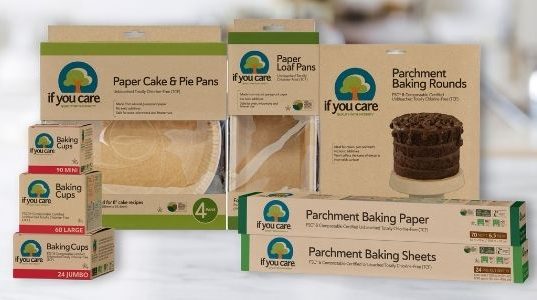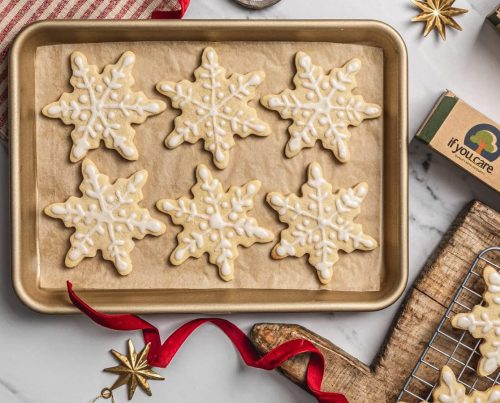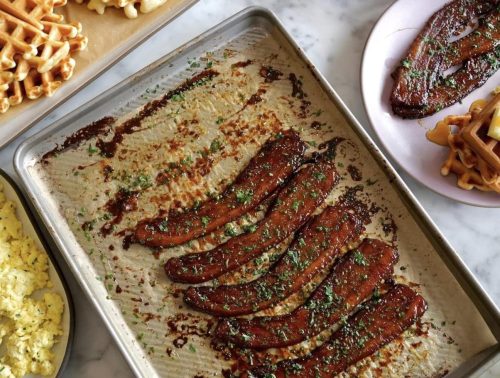If You Care Parchment Baking Paper is an eco-friendly alternative to traditional parchment papers. Made from unbleached, chlorine-free paper and coated with a natural silicone, it caters to environmentally conscious consumers seeking sustainable kitchen solutions. This parchment paper is designed for baking, roasting, reheating, and wrapping.
List of the 12 Best Options ‘If You Care Parchment Baking Paper’
*The table is powered by the AAWP plugin below.
Design & Quality

The parchment paper is unbleached and totally chlorine-free (TCF), ensuring that no chlorine or its derivatives are released into water bodies during production. It is greaseproof and coated with natural silicone for a non-stick surface. The product is available in rolls offering 70 square feet, which is more generous compared to other brands that typically offer 30-45 square feet.
Ease of Use

The non-stick surface eliminates the need for additional greasing, simplifying both baking and cleanup processes. It’s suitable for various applications, including baking, roasting, reheating, and wrapping. Additionally, the product is available in pre-cut sheets measuring 12.5 inches by 16 inches, designed to fit standard metal baking pans, offering convenience for users.
Eco-Friendliness


If You Care Parchment Baking Paper is FSC-certified and compostable, both in home and industrial settings. The use of unbleached, chlorine-free paper and natural silicone coating ensures minimal environmental impact. The packaging is also recyclable, aligning with the brand’s commitment to sustainability.
Pros
- Eco-Friendly and Compostable: Made from unbleached, chlorine-free paper with a compostable silicone coating.
- Generous Quantity: Offers 70 square feet per roll, providing more value compared to other brands.
- Non-Stick Performance: Excellent release properties without the need for greasing.
- Versatile Use: Suitable for baking, roasting, reheating, and wrapping.
- Pre-Cut Sheets Available: Convenient pre-cut sheets fit standard baking pans.
Cons
- Heat Resistance: While suitable for most baking tasks, users should verify the maximum heat tolerance to ensure it meets their specific needs.
- Availability: May not be as widely available in all regions compared to mainstream brands.
Value for Money
Considering its eco-friendly attributes, generous quantity, and versatile applications, If You Care Parchment Baking Paper offers good value for environmentally conscious consumers. The combination of quality and sustainability justifies the investment.
Final Verdict
If You Care Parchment Baking Paper is a commendable choice for those seeking sustainable kitchen products without compromising on performance. Its eco-friendly composition, non-stick capabilities, and versatility make it a valuable addition to any kitchen.
Frequently Ask Questions
1. Is parchment paper the same as baking paper?
Yes, parchment paper and baking paper are essentially the same thing, although terminology may vary depending on the region.
Common Names and Variations
- Parchment Paper (North America): Often used in American English.
- Baking Paper (Commonwealth Countries): More commonly used in places like the UK, Australia, and New Zealand.
Key Features
Both types refer to a non-stick, heat-resistant paper that’s used in baking and cooking tasks. It typically has a thin coating (usually silicone) that prevents food from sticking and makes it moisture-resistant.
Comparison with Similar Products
- Wax Paper: NOT the same as parchment or baking paper. Wax paper is coated with paraffin wax, making it unsuitable for high-temperature cooking since it can melt or catch fire in the oven.
- Butcher Paper: A thicker, uncoated paper used primarily for wrapping meats rather than baking.
Pro Tip: If you’re buying parchment or baking paper, always check for silicone coating (for non-stick) and heat resistance (usually up to 428°F/220°C) to ensure it meets your cooking needs.
2. How to use parchment paper for baking?
Using parchment paper for baking is simple and highly effective for achieving even baking and easy cleanup. Here’s a step-by-step guide to get you started:
Measure and Cut the Paper
- Roll out the parchment paper and place it over your baking tray.
- Cut it slightly larger than the tray to cover the surface fully.
- If you’re using a round cake pan, place the pan on the paper, trace the base, and cut out the shape.
Line the Baking Pan
- Lay the parchment flat on the baking tray or inside the pan.
- If it curls, crumple the paper slightly and flatten it out—it will stay put more easily.
- For cake pans, lightly grease the pan before placing the parchment for better adherence.
Grease if Necessary (Optional)
- Parchment paper is non-stick, so greasing is usually unnecessary.
- However, for particularly sticky recipes (like meringues or marshmallows), a light coating of oil or butter can be helpful.
Place the Batter or Dough
- Arrange your cookie dough, cake batter, or pastry on top of the parchment.
- Leave enough space between cookies for even baking and expansion.
Bake as Usual
- Follow your recipe’s temperature and baking time instructions.
- The parchment paper can typically withstand temperatures up to 428°F (220°C) depending on the brand.
Remove and Cool
- Once baking is complete, carefully lift the parchment paper (with cookies or baked goods still on it) off the tray.
- Place it on a cooling rack to cool completely.
Clean Up (Minimal Effort!)
- Discard or reuse the parchment if it’s clean and undamaged.
- Enjoy the easy cleanup—your baking tray should be free of stubborn food residue!
Pro Tip: To prevent parchment from sliding during baking, add a dab of batter underneath each corner to anchor it in place.
3. Should you use parchment paper when baking cookies
Yes, using parchment paper when baking cookies is highly recommended for several reasons. It makes baking easier and helps achieve better results.
Benefits of Using Parchment Paper for Baking Cookies
✅ Even Baking: The paper creates an insulating layer between the cookies and the baking sheet, promoting even heat distribution and preventing overly browned bottoms.
✅ Non-Stick Surface: Cookies release easily from parchment, even delicate ones like macaroons or sticky chocolate chip cookies. No greasing required.
✅ Easy Cleanup: No scrubbing pans! Simply toss or compost the parchment paper after use.
✅ Batch Efficiency: You can prepare multiple sheets of cookies on parchment paper while using just one baking tray. Simply slide the paper onto a cooling rack and reuse the tray.
✅ Prevents Over-Browning: Ideal for light-colored cookies where you want a delicate golden base.
When Not to Use Parchment Paper
❌ High Heat Baking: If your cookies require extremely high temperatures (above 428°F/220°C), parchment paper may brown or degrade. In such cases, silicone baking mats are a better option.
❌ Crispier Bottoms: If you prefer very crisp or browned cookie bases, direct contact with the baking sheet may be better.
Pro Tip: If you’re out of parchment paper, alternatives like silicone baking mats are excellent reusable substitutes. In a pinch, lightly greased aluminum foil can work, though it doesn’t offer the same non-stick benefits.
4. Can you reuse parchment paper when baking cookies?
Yes, you can reuse parchment paper when baking cookies, but it depends on the condition of the paper after the first use.
When to Reuse Parchment Paper:
✅ Clean Surface: If the parchment paper remains mostly clean with no significant grease, burns, or stuck-on food, it’s good to reuse for another batch.
✅ Low Temperature Baking: Ideal for reusing during short baking sessions (like cookies baked at around 350°F/175°C) since lower heat is less likely to degrade the paper.
When NOT to Reuse Parchment Paper:
❌ Burnt or Darkened Paper: If the edges have darkened or charred, it’s best to discard it to avoid imparting burnt flavors or causing smoke in your oven.
❌ Greasy or Sticky Residue: Grease from buttery cookies can break down the non-stick surface, making it less effective.
❌ Crumbled or Torn Paper: Torn parchment won’t lie flat and can stick to cookies or affect even baking.
Pro Tip: For high-volume baking sessions (like holiday cookie batches), rotating reusable parchment sheets between cookie trays can save time and reduce waste. If you frequently bake, consider silicone baking mats as a more durable and eco-friendly option.











